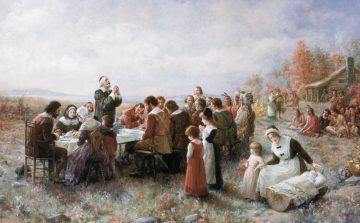Charles Blow in The New York Times:
 When I was a child, Thanksgiving was simple. It was about turkey and dressing, love and laughter, a time for the family to gather around a feast and be thankful for the year that had passed and be hopeful for the year to come. In school, the story we learned was simple, too: Pilgrims and Native Americans came together to give thanks. We made pictures of the gathering, everyone smiling. We colored turkeys or made them out of construction paper. We sometimes had a mini-feast in class. I thought it was such a beautiful story: People reaching across race and culture to share with one another, to commune with one another. But that is not the full story of Thanksgiving. Like so much of American history, the story has had its least attractive features winnow away — white people have been centered in the narrative and all atrocity has been politely papered over.
When I was a child, Thanksgiving was simple. It was about turkey and dressing, love and laughter, a time for the family to gather around a feast and be thankful for the year that had passed and be hopeful for the year to come. In school, the story we learned was simple, too: Pilgrims and Native Americans came together to give thanks. We made pictures of the gathering, everyone smiling. We colored turkeys or made them out of construction paper. We sometimes had a mini-feast in class. I thought it was such a beautiful story: People reaching across race and culture to share with one another, to commune with one another. But that is not the full story of Thanksgiving. Like so much of American history, the story has had its least attractive features winnow away — white people have been centered in the narrative and all atrocity has been politely papered over.
So, let us correct that.
What is widely viewed as the first Thanksgiving was a three-day feast to which the Pilgrims had invited the local Wampanoag people as a celebration of the harvest. About 90 came, almost twice the number of Pilgrims. This is the first myth: that the first Thanksgiving was dominated by the Pilgrim and not the Native American. The Native Americans even provided the bulk of the food, according to the Manataka American Indian Council.
This is counter to the Pilgrim-centric view so often presented. Indeed, two of the most famous paintings depicting the first Thanksgiving — one by Jennie Augusta Brownscombe and the other by Jean Leon Gerome Ferris — feature the natives in a subservient position, outnumbered and crouching on the ground on the edge of the frame. The Pilgrims had been desperate and sick and dying but had finally had some luck with crops.
More here.
